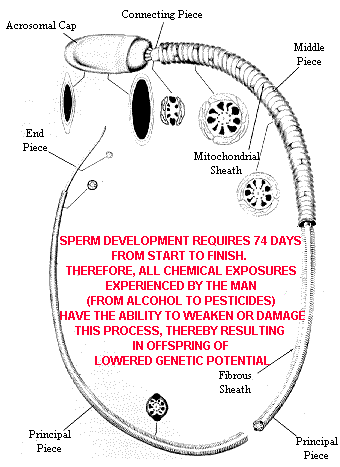| Sperm Damage & Environment
Links
to Attention Deficit Disorder & Learning Disabilities
INTRODUCTION The past five years have shown an increase in studies linking weak or defective sperm to employment in occupations with exposure to chemicals and pesticides (American Journal of Industrial Medicine 24:587-592, 1993). Weak or defective sperm are giving evidence of having an increased risk for problems with pregnancy and the offspring. In a statement from researchers Dr. Hemavathi and Dr. Rahiman of the Department of Biosciences, Mangalore University, India (4), "An elevated level of abnormal sperm is an indication of the mutagenic potency (ability to damage the genetic code) of the test chemical. When treated with a mutagen during spermatogenesis (during sperm development), mice show increased frequency of abnormally shaped sperm heads." As an example of this observation, Dr. Hemavathi subjected mice to levels of three common pesticides - ziram, thiram and dithane M-45 in order to observe effects upon the animals’ sperm. Doses were given daily for five days at one-fourth that which is known to kill 50% of the animals. Results showed all the pesticides caused over a 3 to 8-fold increase in sperm abnormalities such as double heads, small heads, elongated heads, large heads, double tails, coiled sperm, and acrosomes bent upward or downward and some sperm without acrosomes. Understanding of the sequence for male sperm production helps understand the vulnerability of the sperm to environmental/chemical exposures. One common public misunderstanding is that the male manufactures millions of sperm daily, so therefore, activities engaged in weeks or months earlier would then not have an effect upon the sperm quality. This assumption is actually incorrect. Although it is accurate that the human male produces millions of sperm daily, it is important to realize that it takes 64 days to actually create the sperm within the testicles. So therefore, there is over two months worth of time before conception that the male can be exposed to environmental circumstances that could slow or harm the healthy genetic development of the sperm cell. It is now generally accepted that the U.S. male population has shown a large decrease in sperm counts since the 1930’s and 40’s. This in itself does not generate too much concern since conception can occur even with low sperm counts. However, what should generate significant concern is the fact that research reported by several investigators has shown in several species of animals that as sperm count lowers, there is a corresponding increase in the frequency of abnormal pregnancies, such as miscarriages or birth defects (5,6). Combining the information from both of these investigators then suggests that serious consequences could already be appearing due to the continued decline in male sperm counts occurring in the U.S. and other industrialized nations. For More Information on
Environmental Causes of Learning Disabilities
|

